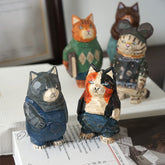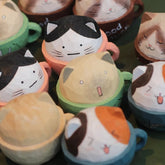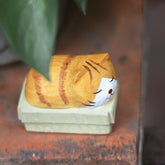Learn to Carve Wooden Gifts: Knife Techniques for Concave Shapes
In this post, we’ll continue refining the shape of our mushroom figurine while teaching you some key techniques for carving concave details on wooden gifts.

First, let’s take a look at our mushroom carving so far. The rounded shape is coming together, but it could be even thinner. The mushroom cap has already been carved inward quite a bit, but we can refine it further.


When creating concave shapes on wooden gifts, using a narrow or curved blade is one option, but there’s another tool that works well too—push carving tools like gouges. Whether it’s a palm gouge or a longer-handled chisel, they can all be useful for this type of work.


These gouges are great for carving concave surfaces, as well as for adding texture like hair or fabric folds. Remember how we said that carving wooden gifts is kind of like playing a video game? The more tools you have, the more options you get! Every shape has a faster and easier way to carve, and the right tool can make all the difference.

For the mushroom’s concave design, we don’t need to carve too deep—just enough to create a subtle inward curve.

We can also carve the edges of the mushroom cap a little thinner. Now, let’s flip it over and check the back. Some areas are already quite thin, but others—especially at the back—are still too thick. To fix this, we’ll shave from the bottom up since the top height should stay the same. If we want to make it thinner, we need to adjust from below.


Looking at the side, we can see that the base of the mushroom could curve upward a bit more. Also, any sharp, unnatural edges left from carving should be softened. After thinning out the back, we might notice that the mushroom stem doesn’t feel quite centered. Sometimes, one side of the cap may extend slightly more than the other. If that happens, we can refine the stem a little more to balance it out.

The key is simple: if an area looks too thick, trim it down. But be careful—once you remove too much, you can’t put it back! Our mushroom has a slightly bulging center rather than a lower bulge, so ideally, it should be a bit slimmer.

At this stage, the overall shape and posture of the mushroom are nearly complete. But something still feels off—it’s not quite as smooth and rounded as we want. That’s because there are still some sharp edges left. The final step is to carefully round them out.


If you’re happy with how your mushroom looks and there’s nothing more to refine, you’re ready for the next step: defining the boundary between the mushroom cap and the stem.

The thinnest areas are near the edges, so we can use a pencil to lightly sketch out the boundary line. It doesn’t have to be perfectly symmetrical—natural mushrooms aren’t perfectly even either!


Alright, that wraps up this lesson on carving wooden gifts! In the next post, we’ll continue working on this adorable mushroom figurine and take it one step closer to completion. Stay tuned!











